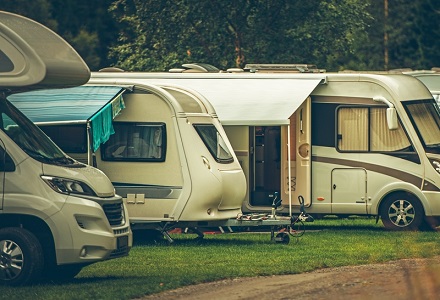

It might be the ultimate definition of stay to play. As youth sports travel – and all its costs – increase, parents are turning to new ways to balance the budget. The RV – long the bastion of those trying to check ‘cross-country road trip’ off their bucket list – has come into its own.
While RV travel to sports events has always been popular among those competing in rodeo and equestrian events (where destinations such as Deschutes Fair and Expo Center, which offers 105 RV hook-ups, have gained popularity) – the use of mobile homes is moving into other areas of youth sports as well.
The Minnesota Star Tribune highlighted a trend among parents to forego flying and hotels in favor of old-fashioned caravanning. The story was focused on youth hockey players.
“In the fiercely competitive world of league hockey, it’s not unusual for parents to pack the kids in the minivan and spend weekends crisscrossing the state for tournaments,” wrote the Star Tribune’s Kevyn Burger. “However, a small but growing number of families with young athletes are forgoing hotels and opting for RVs instead. By setting up makeshift campgrounds — often in parking lots right next to the rinks — parents say they’re saving money, relieving players’ boredom between games and strengthening their ice-based communities.”
Another camp-heavy event, the Waupaca Boatride Volleyball Tournament, held in Oshkosh, Wisconsin, at Brighton Acres, is able to accommodate the number of registrants it has because of camping. The area, which has limited commercial accommodations for lodging in comparison to the registration numbers, has been welcoming RVs for years.
RVs make it possible for families to host multiple children and to cook meals for a cost savings, to travel with as much equipment as they want without incurring extra baggage fees, and to set their own arrival and departure times – something advantageous to parents when children are in a single-elimination tournament.
The new face of the RV market, in fact, is Millennials, who value experiences but are looking for economical ways to get them. According to a blog by Fleetwood RV, “Millennials are changing the way RVs are sold and creating a new marketable demographic in the industry.”
And the RV industry isn’t just the drivable Winnebago or similar bus-like vehicles. In fact, because of the expense of such vehicles, Millennials are buying trailers, pop-ups and small units that they can tow behind a truck. (It’s a good deal for the companies as well, since the buyers tend to become repeat customers as they need repairs, upgrades, or new models as companies add bigger and better features.)
Millennials have also become the chief buyers of add-ons for RVs, with the RV Industry Association noting the RV aftermarket contributes 3,187 jobs, $272 million in wages and over $750 million in total economic output on a yearly basis.
And Millennials have created a sea change in the RV itself, notes the Fleetwood article: “A big turn-off for many Millennials is a vehicle that's very heavy, because it takes a lot of gas to move them, and they can be harder to maintain. The RV industry has responded to Millennials' concerns by making trailers that are lighter and more durable than they used to be. This also makes them easier to pull, with something like a minivan. These design improvements are particularly important because people tend to buy larger RVs as time goes on. If a bigger model of RV uses up much more gas than a buyer's current model, they're much more likely to keep the smaller one, even if they need more space.”
Also driving the market is Millennials’ tech-savvy (and tech-needy) bent. Millennials want different things from previous generations of buyers, so companies have made some significant design changes to their vehicles in recent years. Having access to modern technology is especially important to Millennials, and some younger campers value having Wi-Fi and charging docks as much as having toilet paper. Keeping up with technology in this way sometimes means a significant financial investment for RV makers but keeping a customer base is essential.
In addition, the blog noted, “Millennials like to maximize their space in RVs, and parking in places where they can do that is a major draw to them. Not all places allow RVs to use their slide-outs to increase their space, and while older generations may have been fine with this, Millennials expect more. Campgrounds that offer easy access to technology, with Wi-Fi and electricity, are also important. Many campgrounds on federal lands aren't modernized, and getting them up to date could draw millennial campers to those places, increasing tourism and federal revenue through the RV industry boom.”
Growth in RV sales – and obviously, in RV use – has leant itself to a need for service. And, not surprisingly, mechanics who can service RVs are not as prevalent. As a result, the opening of new RV-specific service areas often gains extensive press, particularly within the hospitality market. The opening of new dealerships likewise gains press.
There is, however, a ceiling to all this growth, and it appears the market may have hit it – at least for now. Most recently, the RV industry has reported a flattening of sales, followed by a downturn, forcing the RVIA to announce layoffs.
According to analysts, however, it is a case of a natural market correction. An uptick in any market can’t continue indefinitely. A Shocking the Street article posted on Seeking Alpha noted that because RV shipments were “white hot” in 2016 and 2017, manufacturers’ conclusions were that the industry would continue to cruise along thanks to a strong economy and expanding Millennial sales demographics – but that number has not continued to grow.
“Industry sales began to crack last year, falling 4 percent year-over-year, and so did the fortunes of certain RV-related names,” according to the post. “Some experts theorized RV manufacturers stuffed the sales channel in 2018 to meet demand that never materialized. Once dealers rationalized inventories, then shipments would return. However, shipments continue to fall.”
Another cost-cutting measure on the part of RVIA was to jettison the 2020 and 2021 installments of its trade show, “RVX: The RV Experience.” The organization held the show just once, last March in Salt Lake City, Utah, but poor attendance led to the Reston, VA-based national trade organization cancelling the other shows.
Whether the downturn is a natural course correction or whether the industry is in for another drop is unknown. Other factors, such as the sharing economy, continue to make a dent in the hotel and motel economy; it is not a stretch to believe the RV industry is feeling the pinch here as well.
SDM will continue to follow this issue.

